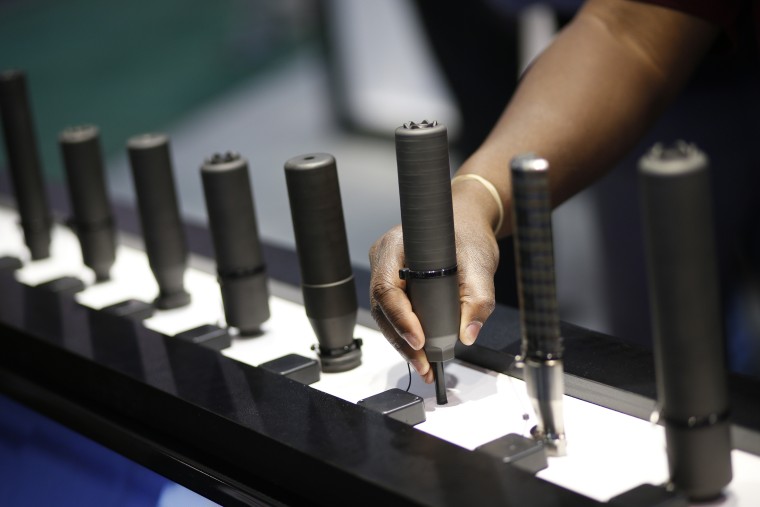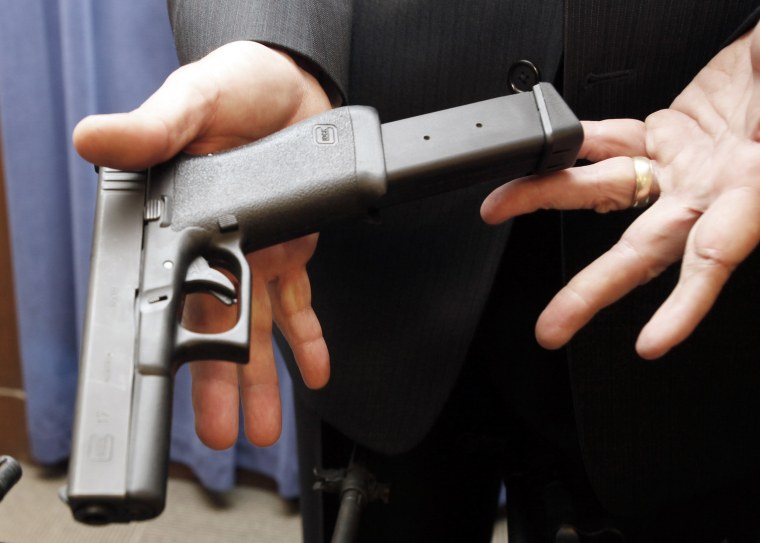The Virginia Beach shooter who killed 12 people on Friday went room to room in the city's municipal building using a silencer that one survivor said made the semiautomatic firearm sound like "a nail gun."
“If it was a regular gunshot, we would've definitely known a lot sooner, even if we would've had 30 or 60 seconds more,” Christi Dewar, who worked at the municipal building, told The Virginian-Pilot. “I think we could've all secured ourselves … all of us could've barricaded ourselves in.”
Now, the legality of firearms silencers, or suppressors, may be among the issues that Virginia lawmakers consider when they meet for a special session on gun control called by the governor in the wake of the massacre.
The state's legislators may also look at high-capacity magazines, which allow a shooter to keep firing without having to pause to reload. The Virginia Beach suspect, DeWayne Craddock, used that device too, according to police.
High-capacity magazines and suppressors have been linked to some past mass shootings, and advocates for gun reform contend that their primary purpose is for mass violence — not gun sports.
“A high-caliber handgun reportedly equipped with a firearm silencer and extended high-capacity ammunition magazines" lacks any purpose "other than increasing the gun’s lethality and functionality for a mass attack,” Josh Sugarmann, the executive director of gun safety group Violence Policy Center, said in a statement.
Others contend that the details of particular weapons are not the main cause of high death tolls in mass shootings.
"It’s not necessarily the specific type of weapon that matters," Pete Blair, the executive director of the Advanced Law Enforcement Rapid Response Training at Texas State University said, based on data his group has collected. "It’s the number of weapons that people bring. Typically in the high-death events, it’s multiple weapons that are brought to the scene."
The Virginia Beach suspect, who died at the scene in a gun battle with the police, was carrying two .45-caliber handguns, police said.
Silencers
Silencers, or suppressors, limit the sound, muzzle flash and kickback of a gunshot when they are attached to the barrel of a handgun or rifle.
But they are not soundless, as they are often depicted in the movies.
"There’s still noise there. That can still impact law enforcement officers when there’s a shooting because it’s harder to track down the shooter. It can delay civilians from responding, but it’s not as if it’s completely silent," Blair said, noting that law enforcement often uses them to protect their hearing.
To Peter Ambler, executive director of the Giffords Law Center to Prevent Gun Violence — a gun-reform advocacy group founded by former U.S. Rep. Gabby Giffords — suppressors make guns more dangerous.
“These devices are meant to suppress the sound of gunfire, to hide muzzle flashes, to confuse the location of an actual gunshot,” Ambler said. “That’s why they’re so difficult for law enforcement when they encounter them in these situations. It makes it more difficult for them to engage an assailant and increases casualties at shootings like this.”

Suppressors are harder to obtain in the U.S. than guns themselves.
The National Firearms Act, passed in 1934, imposed additional tax and registration requirements on silencers, as well as machine guns and short-barreled shotguns. Eight states and Washington, D.C., have put outright bans on the use of silencers since then.
They are legal in Virginia except in certain larger cities, including Virginia Beach. The suspect in the shooting Friday, however, purchased his firearms legally, according to authorities.
To buy a silencer, purchasers have to register their fingerprints and share their photographs with the Bureau of Alcohol, Tobacco, Firearms and Explosives, or the ATF, receive law enforcement certification, pay a $200 tax and fill out an application. Most have to wait months for their paperwork to be cleared.
Even with that difficulty, the number of registered suppressors in the U.S. has soared.
Nearly 1.5 million silencers were registered as of February 2018, according to the ATF. That’s more than five times the approximately 285,000 silencers that the agency reported registered in December 2010.
But advocates for silencers, such as the National Shooting Sports Foundation, contend that the devices help recreational shooters protect their hearing.
Two bills that would have eased the difficulty of buying and registering silencers — the SHARE Act and the Hearing Protection Act of 2017 — were introduced in the last Congress. Both bills seem to have been scuttled, however, following highly publicized shootings at a congressional baseball game in June 2017, at which GOP Rep. Steve Scalise and three others were wounded, and the Las Vegas massacre a few months later that killed 58 and injured hundreds.
Among the advocates for silencer deregulation has been Donald Trump Jr., the president’s son. He appeared in a Utah-based gun manufacturer’s video in 2017 speaking about gun-sports enthusiasts’ need for silencers to protect their hearing and the hearing of children interested in learning the sport.
“It’s a great instrument,” Trump Jr. said in the video. “There’s nothing bad about it at all. It makes total sense. It’s where we should be going.”
High-capacity magazines
The number of rounds carried by handguns and rifles can vary greatly in the U.S. due to few legal limits on magazine capacity. Gun-reform proponents claim that has allowed mass shooters to prolong their attacks.
Ambler of the Giffords advocacy group says gunman Jared Loughner, who attempted to assassinate Giffords in Arizona in 2011, would have inflicted less damage if his gun had carried fewer bullets.
Using a high-capacity magazine that carried 33 rounds for his 9mm pistol, Loughner killed six people and injured at least a dozen others.

“He was only stopped by bystanders when he went to change out his magazine,” Ambler told NBC News on Saturday. “You can see this in many other instances where high-capacity magazines have made a shooting more deadly, and you have to ask, 'Is there any sporting or self-defense purpose for this?'”
But Blair of Advanced Law Enforcement Rapid Response Training said that about one in six attackers are stopped by a potential victim, and that only rarely occurs when the shooter is changing a magazine.
"Usually the civilian is unarmed, and they just tackle the person regardless of whether they’re shooting or not," he said. "In theory, you can shoot more with a larger magazine, and that may mean you can cause more casualties, but there are a lot of other variables that go into that."
Although high-capacity magazines were used in some recent mass shootings — including in Las Vegas, Sandy Hook, Aurora, Orlando and Sutherland Springs, Texas — there are few limits on them in the U.S.
Nine states and Washington, D.C., have passed laws limiting the capacity of clips to 10 to 15 rounds, according to the Giffords Center, but some of these restrictions have failed to survive judicial review.
Most recently, a federal judge found California’s ban on magazines that carry more than 10 rounds of ammunition to be unconstitutional.
Judge Roger Benitez of the Southern District of California wrote that the state's ban “burdens the core of the Second Amendment by criminalizing the acquisition and possession of these magazines that are commonly held by law-abiding citizens for defense of self, home, and state.”
CORRECTION (June 5, 2019, 11:23 a.m. ET): A previous version of this article incorrectly described the gun used in the mass shooting in Thousand Oaks, California, in November. The shooter, Ian David Long, did not use a silencer, according to police.
